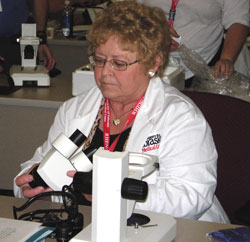 |
Judy Walz, a science teacher from St. Francis Indian School, learns how to put together a new stereo microscope. |
“It’s just like Christmas,” said the science teacher from St. Francis Indian School. “We really don’t have the means or the materials that our students need. This microscope will really come in handy.”
Walz was one of 16 teachers from eight reservations schools in Nebraska and South Dakota who attended a workshop at UNMC in early June. The four-day workshop is part of the $1.3 million Science Education Partnership Award grant Maurice Godfrey, Ph.D., principal investigator and associate professor of pediatrics at UNMC, and co-investigator Roxanna Jokela, director of the Rural Health Education Network at UNMC, obtained in 2006 with the intention of strengthening the math and science curriculum of American Indian youths on reservations in Nebraska and South Dakota.
“SEPA has provided us with not only the materials but the ideas on how to enhance our math and science curriculum,” said Walz, who is in her second year with the program.
Some of the supplies her school has received include a human body torso, life cycle materials and posters displaying various scientific methods.
All of the schools represented were given two microscopes — a monocular and a stereo (binocular) microscope — for their science classroom, Dr. Godfrey said.
All of the teachers were instructed in how to assemble and use both kinds of microscopes.
“We want to encourage the teachers to not be afraid of the equipment and to use it,” he said. “Unfortunately, a lot of these schools have microscopes but they just sit on a shelf in the classroom because the teachers don’t have the time or don’t know how to use it, we hope to familiarize them with it so they will use it.”
Dr. Godfrey said another goal of the workshop is for all of the teachers to leave knowing they have the support of the SEPA program.
“They have our skills and knowledge to help them implement the techniques and concepts they learned during the workshop,” he said.
In the fall, Dr. Godfrey and several others will go to visit each reservation school to make sure the teachers are using the microscopes and answer any questions they might have.
Last winter, Dr. Godfrey paid a visit to St. Francis Indian School to host a science night for students and their families.
“It was really well-received,” Walz said.
And since she began participating in the SEPA program, Walz said she has seen her students’ interest in science sky rocket.
“You can see a lot of motivation in the students,” she said. “None of the students want to miss school on the days I teach science.”